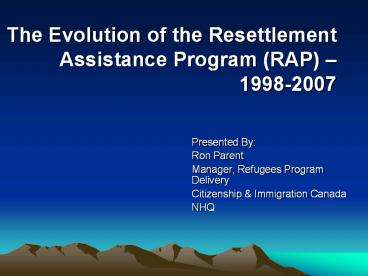The Evolution of the Resettlement Assistance Program (RAP) - PowerPoint PPT Presentation
Title:
The Evolution of the Resettlement Assistance Program (RAP)
Description:
1998 RAP created, replaces AAP. 2002 IRPA Introduced. 2005 New RAP Ts & Cs ... GAR Health Needs. Redesign of RAP. Workplan Year 2. Increase Client Services ... – PowerPoint PPT presentation
Number of Views:35
Avg rating:3.0/5.0
Title: The Evolution of the Resettlement Assistance Program (RAP)
1
The Evolution of the Resettlement Assistance
Program (RAP) 1998-2007
- Presented By
- Ron Parent
- Manager, Refugees Program Delivery
- Citizenship Immigration Canada
- NHQ
2
Overview of Developments
- 1998 RAP created, replaces AAP
- 2002 IRPA Introduced
- 2005 New RAP Ts Cs
- 2006/07 Additional Funding for RAP
3
How the Context has Changed
1998
2007
Now supports 5500-5700 refugees
Supported 5300 refugees
2 refugees from Europe 40 refugees from Africa
66 refugees from Europe 11 refugees from Africa
CONTEXT
Many refugees from protracted camp-based
situations with larger families, limited
life-skills, lacking education and work
experience, poor health
Many urbanized refugees and those in camps for
relatively short periods
4
Impacts
- Service delivery
- Communities and community services, e.g.
- Health
- Education
- Social services
- Other settlement services
- CIC staff involved in program delivery
- Refugees themselves
5
RAP Working Group- Progress Update -
- Background
- Mandate
- Representation
6
Priorities 1st Year
- National RAP Conference
- RAP Inventory
- Staff Training (CIC and SPO)
- Overseas Orientation for GARs
- GAR Health Needs
- Redesign of RAP
7
Workplan Year 2
- Increase Client Services within RAP
- National Roll-Out of Life Skills Program
- Services for Children Youth
- Hold RAP Conference
- Communicable Diseases Training
- Address Health Services for GARs
8
RAP Working Group CIC Perspective
- Ron Parent
9
RAP National Conference 2007
- This week provides all of you with the
opportunity to - Expand skills and increase knowledge
- Share best practices
- Influence the future of RAP program design
- Celebrate the successes of the program































